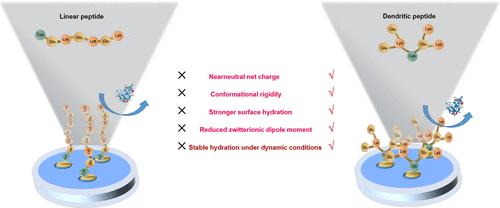Design of Dendritic Zwitterionic Oligopeptides with Superior Antifouling Capability for Electrochemical Detection in Diverse Complex Biological Fluids
IF 6.7
1区 化学
Q1 CHEMISTRY, ANALYTICAL
引用次数: 0
Abstract
Electrochemical biosensors are often compromised by nonspecific adsorption in complex biological fluids. Although zwitterionic peptides (ZIPs) demonstrate excellent antifouling properties through the formation of hydration layers, conventional linear ZIPs face a severe limitation: unstable hydration under dynamic complex conditions due to a longer dipole moment, local charge, and conformational flexibility. To address these limitations, we designed a novel dendritic zwitterionic oligopeptide with a three-dimensional branched architecture by alternating glutamic acid (E) and lysine (K) residues around a cysteine (C) core [e.g., EK(E)CE(K)K] according to traditional linear ZIPs (CEKEKEK). Comparative experiments revealed that the dendritic ZIPs exhibited significantly enhanced hydrophilicity and antifouling performances over linear CEKEKEK when exposed to human saliva, sweat, and even in blood. Molecular dynamics simulations revealed that the flexible CEKEKEK oligopeptide, with 2 intramolecular hydrogen bonds between hydrophilic groups distributed at termini of the polypeptide, exposing the peptide bond at the middle part, undergoes local charge and an uneven and unstable hydrated layer. However, the dendritic EK(E)CE(K)K oligopeptides formed 8 intramolecular hydrogen bonds, lowering the dipole moment between −COOH and −NH2 groups with maintaining high conformational stability, which helps form a stronger hydration layer under physiological conditions than the linear CEKEKEK. Leveraging this design, we successfully developed an antifouling electrochemical biosensor based on this dendritic ZIPs as example for detecting C-reactive protein in saliva, achieving detection accuracy consistent with the ELISA method. The dendritic design provides a strategy for enhancing the contamination resistance ability and offers a significant advancement for next-generation biosensors in complex biological environments.

具有优异防污能力的树突状两性离子寡肽在多种复杂生物流体中的电化学检测设计
电化学生物传感器在复杂的生物流体中经常受到非特异性吸附的损害。尽管两性离子肽(ZIPs)通过水化层的形成表现出优异的防污性能,但传统的线性ZIPs面临着严重的限制:由于较长的偶极矩、局部电荷和构象灵活性,在动态复杂条件下的水化不稳定。为了解决这些限制,我们根据传统的线性zip (CEKEKEK)设计了一种新的树突状双离子寡肽,它具有三维分支结构,由谷氨酸(E)和赖氨酸(K)残基围绕半胱氨酸(C)核心[例如EK(E)CE(K)K]交替形成。对比实验表明,当暴露于人类唾液、汗液甚至血液中时,树突状zip比线性CEKEKEK表现出显著增强的亲水性和防污性能。分子动力学模拟结果表明,具有柔性的CEKEKEK寡肽在多肽末端的亲水性基团之间存在2个分子内氢键,暴露了中间部分的肽键,发生了局部电荷和不均匀不稳定的水合层。然而,树突状EK(E)CE(K)K寡肽在分子内形成8个氢键,降低了−COOH和−NH2基团之间的偶极矩,保持了较高的构象稳定性,这有助于在生理条件下形成比线性CEKEKEK更强的水合层。利用这一设计,我们成功地开发了一种以这种树突状zip为例的防污电化学生物传感器,用于检测唾液中的c反应蛋白,其检测精度与ELISA方法一致。树突状设计提供了一种提高抗污染能力的策略,并为复杂生物环境中的下一代生物传感器提供了重大进展。
本文章由计算机程序翻译,如有差异,请以英文原文为准。
求助全文
约1分钟内获得全文
求助全文
来源期刊

Analytical Chemistry
化学-分析化学
CiteScore
12.10
自引率
12.20%
发文量
1949
审稿时长
1.4 months
期刊介绍:
Analytical Chemistry, a peer-reviewed research journal, focuses on disseminating new and original knowledge across all branches of analytical chemistry. Fundamental articles may explore general principles of chemical measurement science and need not directly address existing or potential analytical methodology. They can be entirely theoretical or report experimental results. Contributions may cover various phases of analytical operations, including sampling, bioanalysis, electrochemistry, mass spectrometry, microscale and nanoscale systems, environmental analysis, separations, spectroscopy, chemical reactions and selectivity, instrumentation, imaging, surface analysis, and data processing. Papers discussing known analytical methods should present a significant, original application of the method, a notable improvement, or results on an important analyte.
 求助内容:
求助内容: 应助结果提醒方式:
应助结果提醒方式:


